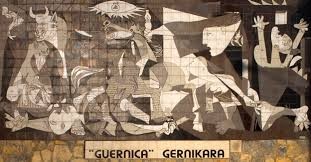On this website you will find a separate story about the bombing that took place during the Second World War. The bombing of Nijmegen has been added separately, initially to give an idea of how a bombing of Nazi Germany started, but in the second instance also because it was a special “friendly fire” bombardment.
What has not been described so far is the bombardment of the German Condor legion and the Italian Aviazione Legionaria on the Basque city of Guernica. Logical, because this bombardment took place a number of years before the actual beginning of the Second World War, on April 26, 1937. The Condor Legion was a military unit of volunteers from Nazi Germany and the Aviazione Legionaria a unit from Italy with the aim of assisting Franco in his plans. Hermann Göring confirmed after the end of the Second World War that the bombing of Guernica should be seen as a test for the Luftwaffe.

In Spain, from July 19, 1936 to April 1, 1939, a fierce civil war raged, with on the one hand the Nationalists of General Franco (the rebels) and the Republicans, the legitimate government. Franco committed a military coup from the south against the legal government and wanted to conquer the northern provinces as soon as possible. Franco was supported by right-wing and conservative groups and the Germans and Italians. The incumbent government was supported by the Communists and anarchists and the support of (more or less) France and England and Russia. The northern provinces, the Basque Country, also supported the legitimate government.
Franco decides, on the advice of his staff and the Germans, to turn an attack on the north on the defensive line Bilbao, Durango and Guernica. Emilio Mola, the commander of the Nationalists, wanted to take Bilbao and then move westward to Durango and Guernica. Wolfram van Richthoven, the commander of the German Condorlegion wanted to tackle and accelerate the attack differently by bombing and destroying Durango, an important crossroads for military traffic, and Guernica. On March 31, 1937, Durango was bombed, estimated 170 to 200 dead. At Guernica it was especially important from a strategic point of view to bomb the bridge over the river.

On April 26, 1937, the church bells of Guernica warned of an imminent airstrike. The inhabitants quickly looked up the bomb shelters. Indeed, one Heinkel HE 111 appeared at the firmament and threw his bombs above the city. Nothing else happened, so the residents left the bomb shelters again. A quarter of an hour later, however, a full squadron of Ju 52 and Savoia Marchetti SM.81 aircraft appeared that bombed the city with small bombs, 250 kg bombs and brisant bombs. The city was destroyed for 80%. Von Richthoven also decides to shoot at the fleeing inhabitants. The number of victims differs from source to source, the estimate is between 300 and 800 deaths. Strangely enough, the bridge, the original target of the bombardment and the “Oak of Guernica” was not hit. The “Oak of Guernica” symbolized the rights and freedom of the Basque people.
Two days later, Franco takes the city and the conquest is world news. At first it was claimed that the houses had not been bombed but had been destroyed by Basque terrorists, but a shot down German pilot, Joachim Wandel, confessed that there was indeed bombed.
Why was there no help on the side of the nationalists? The quirky commander of the Russian air squad of Yakov Smushkevich, did not think it necessary to intervene and had therefore not prepared his fleet. This self-willed performance was challengeable for Republicans. France did not have an opinion but was not charmed by a communist threat from Spain and England was actually more on Franco’s hand but refused to acknowledge this point of view openly. In the end, Franco wins the war and Nazi Germany has an ally again.
The German Condor legion was received as heroes when they returned to Germany in Hamburg and Berlin.
Pablo Picasso

Pablo Picasso received a request from the Republicans to create a work for the World’s Fair in Paris in 1937. Picasso decided to take the events at Guernica as a subject. Picasso had an aversion to violence and to Franco.
The canvas was 27 square meters in size, was named Guernica and was delivered to Paris the second half of June 1937.
Accompanying poem by Paul Eluard:
“The death and abhorrence of our enemies have the monotonous color of the night.”
Source:
Isgeschiedenis.nl
History.net
Various Wikipedia articles